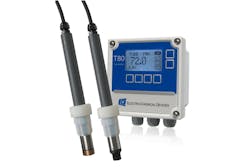Turbidity Analyzer Simplifies Suspended Solids Measurement
The Triton TR86 turbidity analyzer includes an intelligent transmitter and near-infrared (IR) optical sensing capabilities, which provides ease of installation, accurate measurement and reliable operation.
The measurement of suspended solids (turbidity) in water is critical in a wide range of treatment applications, especially in municipal services. Clay and silt particles typically are suspended in water, and they give a cloudy or hazy appearance in samples. Such particles can become homes for bacteria and viruses that attach themselves; they are dangerous and generally indicate a low overall quality of treated water.
The TR86 features an advanced transmitter combined with ECD’s T80 universal analyzer; together they provide reliably accurate turbidity monitoring with the capability to add a second measurement parameter—such as pH, oxygen reduction potential, conductivity, dissolved oxygen or various pIONs—to the system.
The flexible TR86 turbidity analyzer comes in a choice of three separate ranges from 0 to 4,000 nephelometric turbidity units (NTUs) for continuous measurement. Its IR optical sensing technology emits an 850-nanometer beam of near-infrared light into the sample, where it is scattered by the particles suspended in the water. Measurement is achieved when the amount of scattered backlight returns to the sensor, which then is correlated to the amount of suspended solid particulates in the water.
The TR86 sensor’s measurement response time depends on the size, shape and composition of the suspended particles. This requires that mg/L, ppm and the percentage of suspended solids must be calibrated with the monitored water sample. Turbidity measurements (NTUs or Formazin nephelometric units) can be calibrated with standards such as Formazin, StablCal or SDVD beads.
